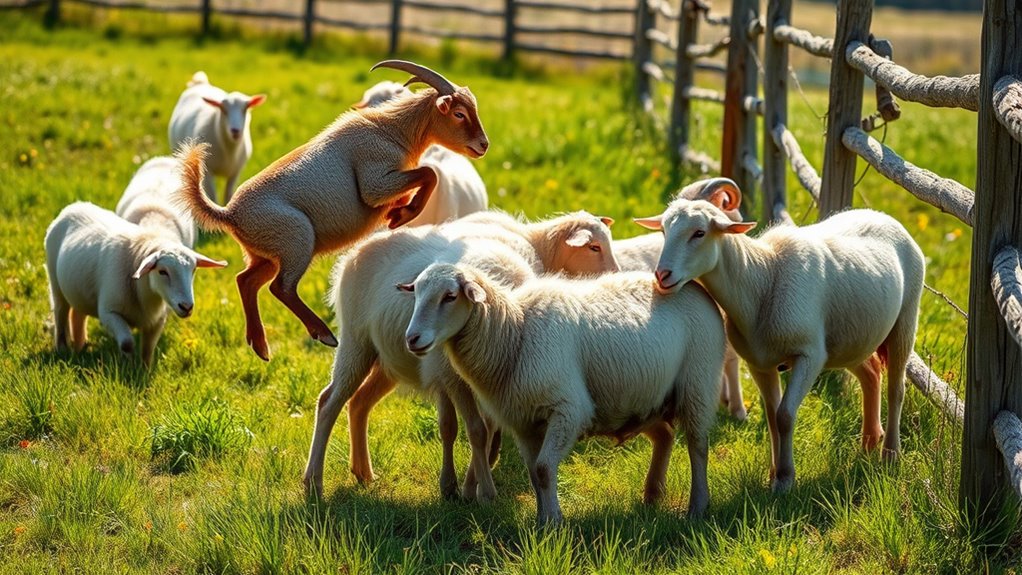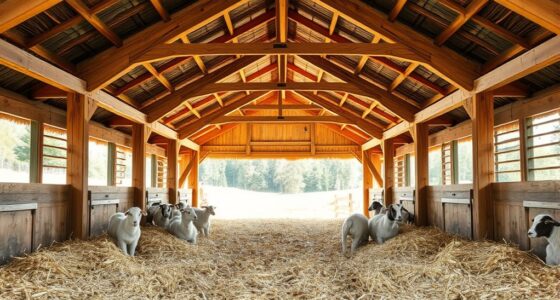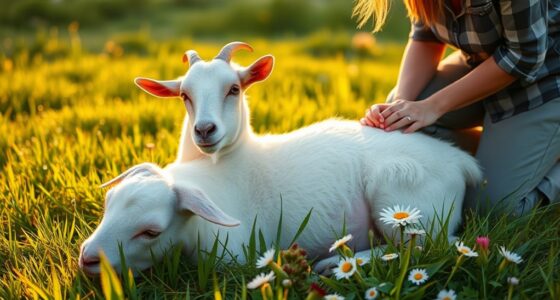Yes, goats and sheep can live together successfully! Just know they have different behaviors and health needs. Goats are browsers and need more space, while sheep are grazers with a strong flocking instinct. You'll also need to manage diseases like brucellosis and ensure proper fencing. Regular health checks and vaccinations are crucial too. By understanding their unique habits and requirements, you can create a harmonious environment. Discover more tips for ensuring compatibility and productivity together!
Key Takeaways
- Goats and sheep can coexist, but their distinct behaviors require careful management to ensure harmony in the mixed herd.
- Mixed grazing leverages their different dietary preferences, allowing sheep to graze while goats browse, optimizing pasture utilization.
- Proper fencing is crucial; use high tensile or woven wire for goats and ensure it is goat-proof to prevent escapes.
- Regular health checks and vaccinations are essential to prevent disease transmission between species, particularly for parasites affecting goats.
- Understanding and adapting to their social behaviors aids in creating a peaceful environment, with sheep flocking and goats needing space.
Understanding Shared Diseases
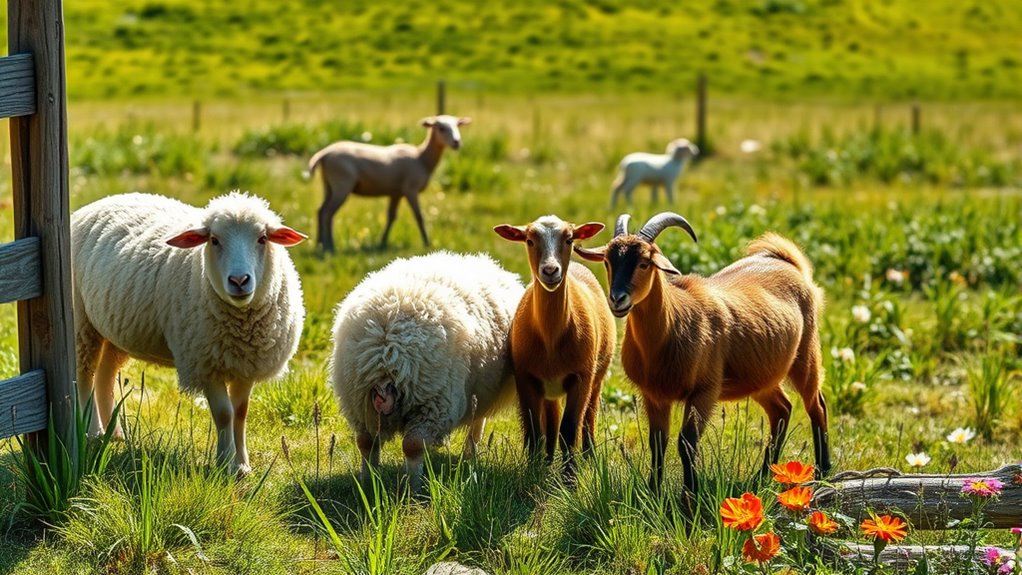
When managing goats and sheep together, it's crucial to understand the shared diseases that can affect both species. Both can transmit infections like brucellosis and caseous lymphadenitis.
Viral diseases, such as bluetongue and caprine arthritis encephalitis (CAE), also pose a risk. Parasitically, *Haemonchus contortus* and *Fasciola hepatica* can affect both.
Viral threats like bluetongue and CAE, along with parasites such as *Haemonchus contortus*, can impact both goats and sheep.
To prevent these issues, vaccination is key. Clostridial vaccines and those for specific diseases should be part of your herd management plan.
Implement good hygiene practices, regular deworming, and effective pasture management to minimize disease spread. Make sure to monitor health closely and consult a veterinarian for tailored vaccination programs.
Early detection and intervention can save your flock and herd from serious health problems.
Behavioral Differences Between Sheep and Goats
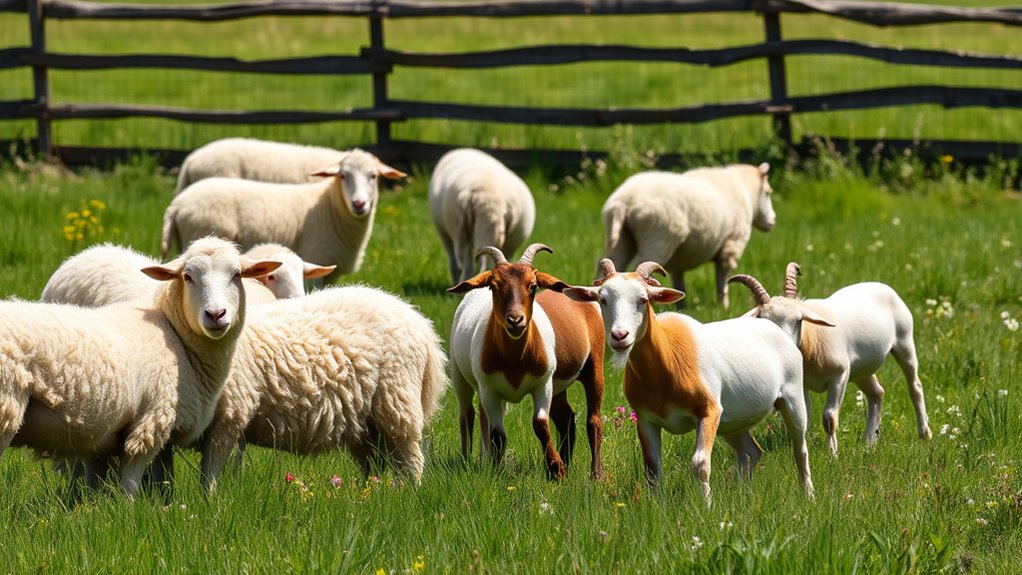
Understanding the behavioral differences between sheep and goats can significantly enhance your management practices.
Sheep are grazers with a strong flocking instinct, making them more social and easier to handle. They stick together for safety, which aids in predator protection.
On the other hand, goats are browsers and more independent, often forming smaller family units. Their curious and exploratory nature leads them to wander further, so they require more space.
When threatened, sheep stay close, while goats scatter and use their agility to escape.
These behavioral traits impact training, as sheep respond well to handling, whereas goats need individualized training approaches.
Recognizing these differences helps create a harmonious environment for both species.
Grazing Habits and Pasture Utilization
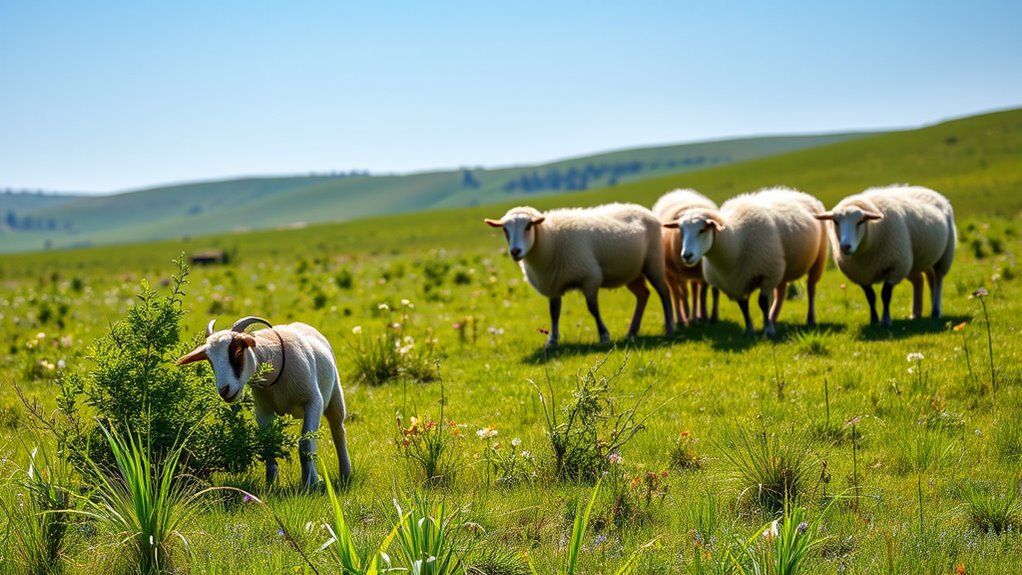
Recognizing the behavioral differences between sheep and goats sets the stage for effective grazing and pasture management.
Sheep primarily graze on grasses and small plants, while goats prefer woody plants and shrubs. This difference means that mixed grazing can optimize pasture utilization, as each species targets distinct plant species.
You'll find that goats are more flexible in their diet and can thrive on poorer-quality forage, unlike sheep, which require better-quality options.
Adjusting stocking density is crucial, as it maintains plant health and encourages regrowth.
Additionally, keep in mind that both species have varying grazing patterns, and understanding these can significantly enhance your pasture's productivity while reducing weed issues.
Fencing Requirements for Mixed Herds
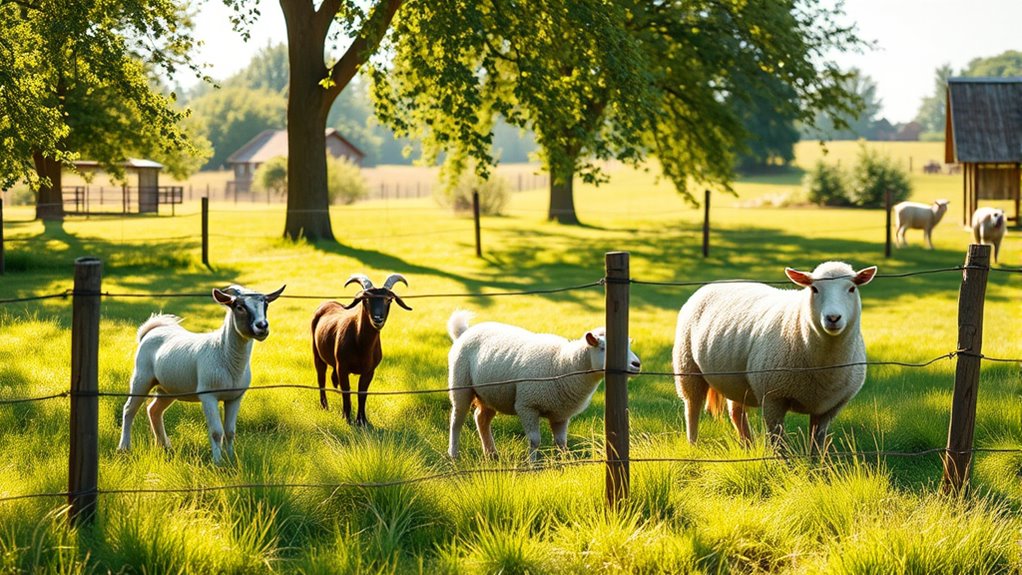
To successfully manage mixed herds of goats and sheep, it's crucial to implement proper fencing that caters to both species' unique needs.
Use high tensile wire or woven wire for durability, ensuring the fence stands at least 36 to 48 inches high to keep goats contained. For sheep, lower fencing can suffice, but goat-proofing is essential.
Ensure durable fencing with high tensile or woven wire, standing 36 to 48 inches to effectively contain goats while considering sheep's needs.
Incorporate barbed wire at the bottom to deter predators and prevent digging. Consider electric fencing for added security, especially against threats like coyotes.
Regular maintenance is key; check for damage and ensure the fence remains effective. Tailoring your fencing to both goats and sheep will minimize escape risks and enhance safety, providing peace of mind for you and your animals.
Productivity Benefits of Mixed Farming
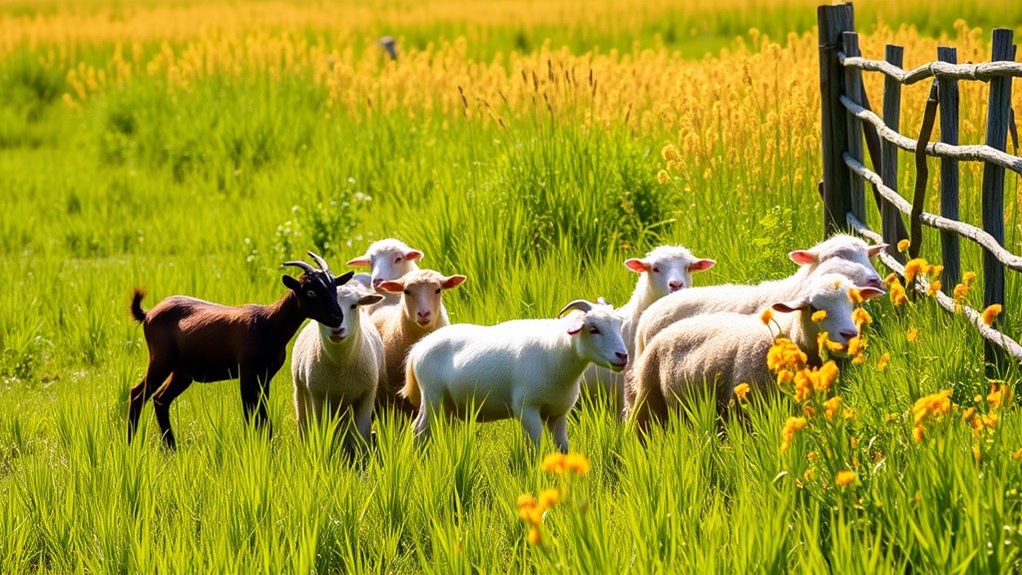
When you combine goats and sheep in mixed farming, you tap into numerous productivity benefits that can enhance your overall operation.
Their complementary foraging habits improve pasture utilization, increasing milk and meat production. By allowing natural grazing, you can reduce the need for chemical herbicides, promoting healthier pastures and supporting biodiversity.
Additionally, goats help control invasive plant species, improving land quality. The manure from both species enriches the soil, cutting down on fertilizer needs.
You'll also enjoy diversified income streams through wool, meat, and milk sales. This mixed approach not only boosts profitability but also creates a more resilient farming system that can withstand market fluctuations.
Management Considerations for Coexistence

Successfully managing goats and sheep together requires careful attention to their unique needs and behaviors. Start by addressing parasite management; both species can share parasites, so regular monitoring is essential.
Implement pasture rotation, though it can be tricky with mixed herds. Next, focus on fencing—goats need stronger, well-maintained enclosures to prevent escapes. Ensure the fencing is goat-proof, as they can jump high.
Consider dietary differences; create mixed pastures with diverse forage and separate feeding areas to meet their nutritional needs.
Lastly, provide adequate shelter tailored to each species. Goats need substantial protection from harsh weather, while sheep require minimal shelter.
Importance of Health Checks and Vaccinations
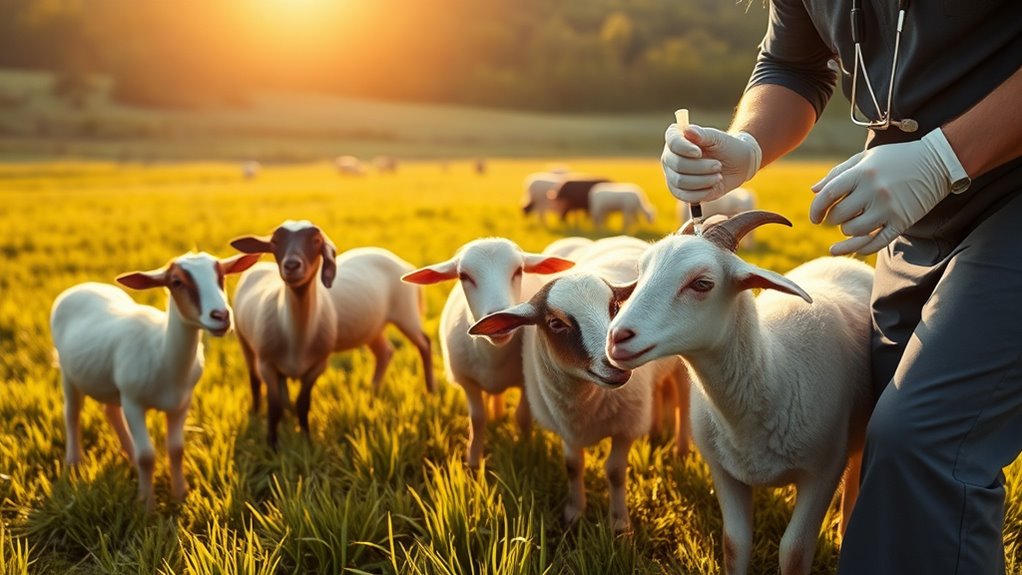
Health checks and vaccinations play a vital role in keeping your goats and sheep healthy and preventing disease outbreaks. Regularly monitoring for parasites is essential, especially since goats are more susceptible to worms.
Keep an eye out for any signs of illness to catch issues early and reduce the risk of spreading diseases. Collaborate with your veterinarian for tailored health management plans and vaccination schedules.
Ensure your animals receive the CDT vaccination, which protects against overeating disease and tetanus. Since goats may have adverse reactions, monitor them closely after vaccinations.
Ensuring Adequate Space and Shelter
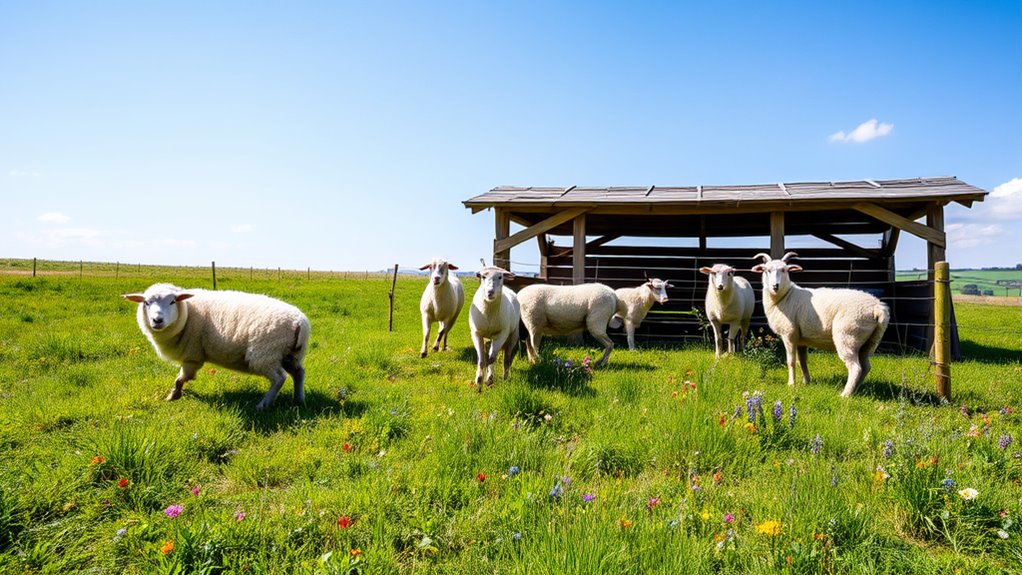
Providing adequate space and shelter is crucial for the well-being of both goats and sheep. Each adult animal needs about 1.5 to 2 square meters of covered space, plus extra room for exercise.
Young animals like lambs and kids require less, so adjust accordingly. When grouping your animals, consider their age, size, and reproductive status to reduce stress and aggression.
For shelters, choose structures that protect from rain, wind, and extreme temperatures while ensuring proper ventilation. Additionally, design shelters for easy access and maintenance.
Don't forget to provide separate areas for different groups, like males and females, to keep harmony in your flock. With the right setup, your goats and sheep will thrive together.
Strategies for Gradual Introduction
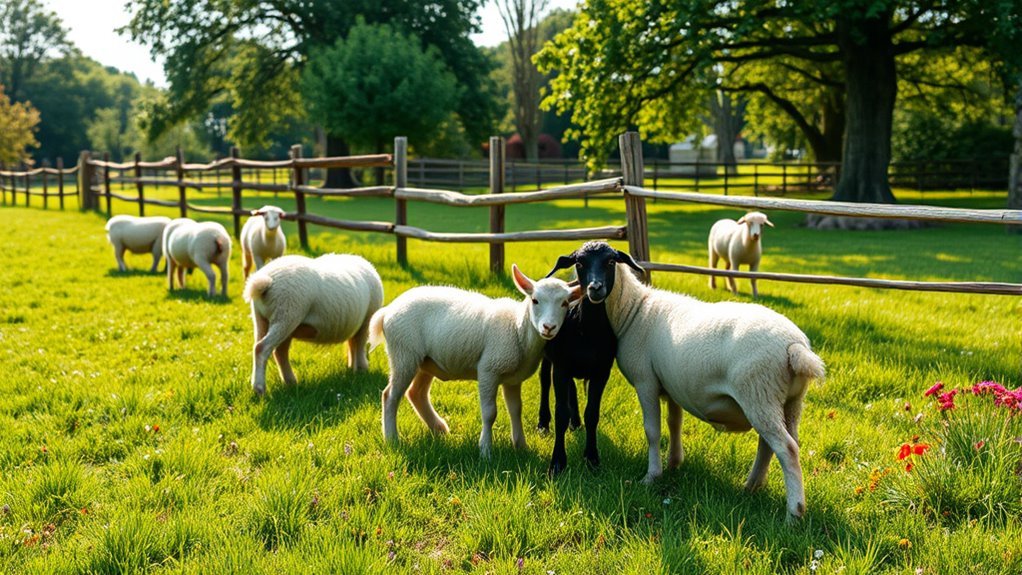
When introducing goats and sheep, it's essential to take a gradual approach to ensure a smooth transition and minimize stress.
Start by keeping them in separate enclosures, allowing you to monitor their behavior. Next, let them see each other through a fence to spark curiosity without direct contact.
Once they seem comfortable, arrange short, supervised meetings in a neutral area. Gradually increase their time together, always watching for signs of stress or aggression.
Frequently Asked Questions
What Are the Signs of Stress in Sheep and Goats?
When you're observing sheep and goats, watch for signs of stress.
For sheep, look for panting, behavioral changes like seeking shade, and physical symptoms such as weakness.
Goats may exhibit open-mouth breathing, vocalizations, and muscle tremors.
Both species react to high temperatures and humidity, which can worsen their condition.
If you notice these signs, it's crucial to provide proper nutrition, shade, and ventilation to help them manage stress effectively.
How Do I Manage Feeding for Both Species?
Feeding sheep and goats is like orchestrating a symphony; each note matters. To manage their diets effectively, provide high-quality hay and grains that satisfy both.
Keep their feeding heights in mind—goats enjoy munching from above. Incorporate diverse pastures to cater to their different tastes.
Monitor their health regularly to ensure they thrive on their unique diets. With a little planning, you'll create a harmonious feeding routine that benefits both species.
Can Sheep and Goats Share Water Sources?
Yes, sheep and goats can share water sources, but you'll need to consider their different drinking habits.
Design a waterer that accommodates both species' sizes and ensures it's easily accessible. Monitor the flow rate to keep up with their needs, and maintain hygiene to prevent cross-contamination.
Regularly check the water for cleanliness and temperature, so both animals stay hydrated and healthy. This way, you can effectively manage their water consumption together.
What Breeds of Sheep and Goats Are Most Compatible?
When considering which breeds are most compatible, you might want to look at Pygmy goats and Dorper sheep, as they often coexist peacefully due to their gentle natures.
Boer goats and Suffolk sheep can also make a great pair, thanks to their robust and friendly temperaments.
Kiko goats and Dorper sheep can thrive together, given their adaptability.
Ensuring a balanced environment and monitoring their interactions will help maintain harmony among them.
How Do I Prevent Fighting Between the Species?
To keep peace in your pasture, think of it as a delicate dance.
You'll want to gradually introduce your goats and sheep, allowing them to find their rhythm without stepping on each other's toes. Make sure there's plenty of space for both to roam freely.
Keep a close eye on their interactions, and if tempers flare, separate the feistier individuals.
With patience and vigilance, you can foster a harmonious environment for all.
Conclusion
In conclusion, keeping goats and sheep together can be like weaving a vibrant tapestry—each animal brings unique colors and patterns to the mix. By understanding their differences, managing their health, and ensuring adequate space, you can create a harmonious environment. With the right approach, these two species can thrive side by side, enriching your farming experience. So, take the time to nurture their coexistence, and you'll reap the benefits of a diverse and productive herd.

